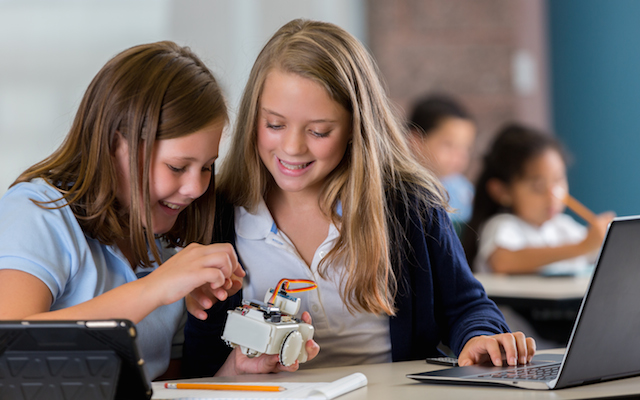How every child can love science and maths.
For many parents and teachers, it can be a struggle to get kids excited about learning maths and other “STEM” (science, technology, engineering and maths) subjects.
As STEM-related industries such as data science and biotech continue to boom, education experts agree that learning these skills is essential to our children’s’ futures – and to Australia’s competitiveness.
But it’s easy to foster of love of science, numbers and problem solving in your children – regardless of personality type – without relying just on worksheets and flashcards.
In the last few years, parents, educators and innovative Australian businesses have injected creativity to STEM subjects to make them more attractive to children.

Science, technology, engineering and maths can be made appealing to all kids
Building a bridge to understanding: Bricks4Kids
Lego has long been a way to introduce kids to basic physics and engineering.
Bricks4Kids uses the popularity of Lego to drive interest in STEM subjects block by block.
During holiday programs, lunchtime clubs, school incursions, birthday parties and robotics classes, Bricks4Kids teaches primary school students a variety of diverse topics ranging from science (Newton’s Laws of Motion) to technology (coding using powered Lego and a program called Scratch).
Joanne O’Brien, Master Franchise Owner of Bricks4Kids Victoria says its children’s love of Lego that makes their approach so effective. “Lego is such a familiar medium, making it possible to introduce students to unfamiliar concepts.”
Children are assigned custom Lego designs and instructions. In building their powered Lego creations, they’re immersed in a range of subjects from maths to design to science. And through working together, they develop critical thinking skills.

With STEM subjects, it’s all in the presentation
Digital thinking: Coding Kids
Digital technologies will be introduced as a subject into Australian schools in 2017, much to the delight of Emily de la Pena.
As founder of Coding Kids, a company that hosts coding and robotics clubs at schools around South East Queensland, de la Pena is a passionate advocate for STEM education.
With four programs aligned with the Australian Curriculum, de la Pena has seen over 500 students go through the Coding Kids program.
Coding Kids makes STEM subjects attractive to children by teaching them to create computer games.
“Kids already love computer games,” de la Pena says, “so why not learn to build your own and learn something in the process?”
Building computer games teaches children about programming concepts including computational thinking, problem solving, logic, maths and graphic design.

Emily de la Pena has seen over 500 students go through the Coding Kids program
“Coding is a great way to engage any student in STEM subjects,” says de la Pena. “It’s a skill that empowers students to create, build and collaborate.”
“They can build a game, animation movie, or digital project with dragons and witches, or unicorns and rainbows or puppies and kittens,” says de la Pena.
“Students are engaged because they get hooked on the ability to create with their wildest imagination as the only limit. As Steve Jobs once said: ‘Computer science is a liberal art’.”
Your everyday STEM-enhancers
You don’t need to enroll your children in a course to foster their love of maths, science and technology. The key is in building on a base of knowledge that your child has already.
Here are some ideas you can use to encourage a greater love of STEM subjects in your children.
- Build a tree house: Few things in childhood are as fun as a well-built treehouse. Measuring and collecting materials teaches kids about arithmetic, geometry, and the construction teaches kids about engineering.
- Learn sports statistics: Knowing your football club’s average ratio of disposals to goals might not be every kid’s cup of tea, but for the young football fan, delving deeper into the statistics of sport is a way to make maths come alive.
- Fold paper aeroplanes: Paper planes are a brilliant way to teach students about physics and aerodynamics. Leonardo da Vinci was a pioneer in paper plane design, seeing their value in demonstrating scientific principles like how air resistance affects motion.
- Practise cooking: Learning to cook develops a range of skills, which may seem unrelated to STEM subjects. Simple tasks such as weighing and measuring teaches basic arithmetic, while studying the way ingredients interact – like raising flour in a chocolate cake – is a fun introduction to chemistry. Even something as simple as slicing up a pizza can teach your child fractions.
- Puzzles and board games: Board games – especially chess – build analytical skills, crucial for success in STEM subjects. Competitive games that focus on counting or statistics can also make basic arithmetic fun.
- Fold origami cranes: Creating beautifully balanced origami teaches kids a love of geometry and precision.
Lastly, adapt these essentials to your children’s needs and developmental stage; as they grow up, so can their palette of tools and materials.
And don’t forget to clear some space on the fridge! Who needs a Picasso? Your family’s art gallery will be second-to-none.


 has the facebook
has the facebook




